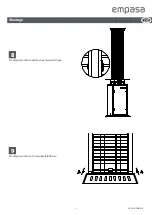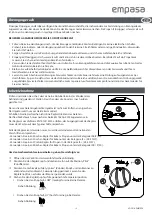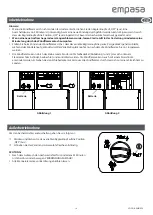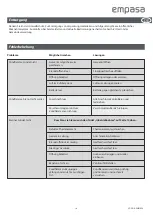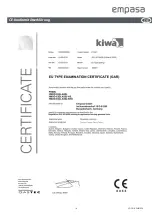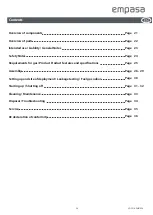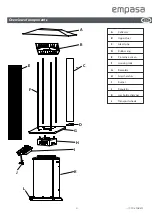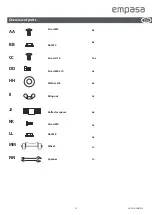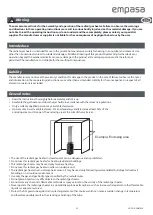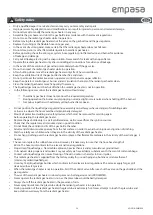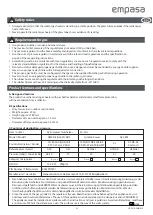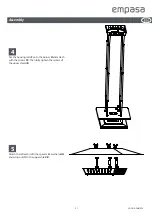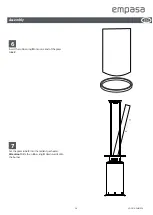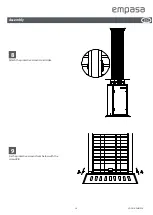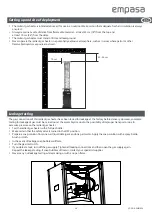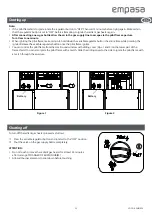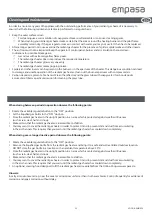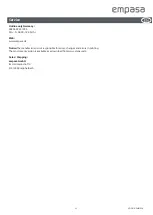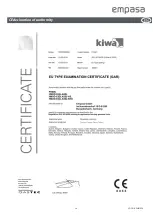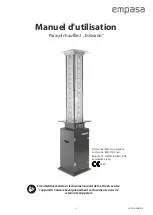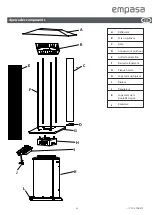
Safety notes
Ÿ
Only a qualified expert / service technician may carry out assembly and repairs.
Ÿ
Improper assembly, adaptations and modifications can result in injuries to persons and material damage.
Ÿ
Do not attempt to modify the radiant gas heater in any way.
Ÿ
Assemble the gas heater and store the gas bottle in accordance with the relevant regulations.
Ÿ
Do not move the radiant gas heater while in operation.
Ÿ
Before moving the radiant gas heater shut the valve on the gas bottle and the gas regulator.
Ÿ
Replace the tubing or the flexible hose once per year.
Ÿ
In the event of a strong wind, make certain that the radiant gas heater does not fall over.
Ÿ
Do not store petrol or other flammable liquids in the radiant gas heater.
Ÿ
Before operating check the entire gas system, hose regulator, pilot flame device and burner for evidence
of leakage and damage.
Ÿ
Carry out all leakage testing with a soap solution. Never search for leaks with an open flame.
Ÿ
Operate the radiant gas heater only after controlling all connections for evidence of leakage.
Ÿ
In the event of the evolution of gas odour, immediately shut off the gas valve.
Ÿ
Do not transport the radiant gas heater while in operation.
Ÿ
After shutting down, move the radiant gas heater only after it has cooled down.
Ÿ
Keep the ventilation slits of the gas bottle chamber free and clean.
Ÿ
Do not paint over the protective screen, operator's control panel or upper reflector.
Ÿ
Keep the operator's control panel, burner and air circulation channels of the radiant gas heater clean.
Ÿ
Clean the radiant gas heater more frequently if necessary.
Ÿ
The liquefied gas tank must be shut off when the radiant gas heater is not in operation.
Ÿ
In the following cases control the radiant gas heater without delay:
Ÿ
F
The radiant gas heater does not produce the required temperature.
F
During operation the burner causes popping noises (a slight noise is normal when shutting off the burner).
F
Gas odour together with extremely yellow burner flame peaks.
Ÿ
Do not position the liquefied gas regulator/hose assembly on pathways where a danger of stumbling exists
or in an area where the hose could be unintentionally damaged
Ÿ
Mount all protective cladding and safety devices which must be removed for servicing again
before operating the radiant gas heater.
Ÿ
Replace the gas bottle only in a well-ventilated area, well removed from the ignition sources.
Ÿ
Check that the regulator seal is mounted and in good condition.
Ÿ
Do not block the ventilation slits of the gas bottle chamber.
Ÿ
Adults and children must keep away from the hot surfaces in order to avoid burn injuries and ignition of clothing.
Ÿ
Watch carefully over children when they are in the vicinity of the radiant gas heater.
Ÿ
Do not hang clothing over the radiant gas heater or place other flammable materials in the vicinity of the radiant gas #
heater.
Ÿ
The user can replace the rubber hose alone. However, it is necessary to note that the hose has a length of
60 cm. The hose must conform to the relevant national regulations.
Ÿ
Properties of liquefied gas – flammable, explosive, heavier than air and accumulates at ground level.
Ÿ
In its natural state propane is odourless. For your safety we have added a substance with the scent of rotten cabbage.
Ÿ
Contact with liquefied gas can cause freezing of the skin similar in character to burn injuries
Ÿ
This radiant gas heater is supplied from the factory solely for use with propane, butane or mixtures thereof
(commonly called liquefied gas).
Ÿ
Use only 15 kg liquefied gas bottles which conform to the relevant local regulations (the same as apply for gas grill
devices) with safety valves.
Ÿ
When the radiant gas heater is not in operation, SHUT the control valve. After use shut the valve on the gas bottle and the
gas regulator.
Ÿ
The use of the radiant gas heater in closed spaces can be dangerous and is PROHIBITED.
Ÿ
Never operate the radiant gas heater in rain, as the glass tube would be badly damaged.
Ÿ
Always shut off the radiant gas heater in the presence of rain.
Ÿ
Never spray liquids onto the glass tube while the radiant gas heater is in operation.
Ÿ
During operation of the radiant gas heater the glass tube is extremely hot. Never attempt to touch the glass tube and
keep children well away from the radiant gas heater.
24
V2/2018-EM01020
EN


